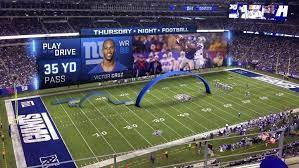Introduction
In the ever-evolving landscape of sports, technology continues to play a transformative role, enhancing the viewer experience and providing athletes with new tools for performance improvement. Augmented Reality (AR) has emerged as a groundbreaking technology with the potential to redefine how sports are both consumed and played. This article explores the impact of augmented reality in sports, from immersive fan experiences to innovative training methods for athletes.
Enhanced Fan Engagement
Augmented reality has revolutionized the way fans engage with their favorite sports. AR applications allow fans to experience immersive content, such as virtual player stats, 3D replays, and interactive elements overlaid onto the live broadcast. This heightened level of engagement transforms the viewing experience, making it more interactive and dynamic.
Virtual Stadium Experiences
AR enables fans to bring the stadium experience into their homes. Through AR applications, fans can create a virtual stadium environment, complete with crowd noise, interactive features, and even virtual merchandise. This not only provides an alternative for remote fans but also enhances the overall enjoyment for those attending live events.
Real-Time Data Overlays
One of the significant impacts of AR in sports is the integration of real-time data overlays during broadcasts. Fans can access live statistics, player information, and tactical insights overlaid onto the live feed. This not only enriches the viewing experience but also provides a deeper understanding of the game, empowering fans to become more informed spectators.
Interactive Training for Athletes
For athletes, augmented reality offers a revolutionary approach to training. AR applications can provide interactive training scenarios, allowing athletes to simulate game situations, analyze their performance, and receive real-time feedback. This immersive training experience enhances skill development and decision-making in a controlled virtual environment.
Injury Prevention and Rehabilitation
AR technology is increasingly being utilized in sports for injury prevention and rehabilitation. Athletes can use AR applications to visualize and analyze their movements, identifying potential areas of strain or injury risk. This proactive approach to injury prevention contributes to the overall well-being and longevity of athletes’ careers.
Tactical Analysis and Strategy Development
Coaches and teams leverage augmented reality for in-depth tactical analysis and strategy development. AR applications enable coaches to superimpose tactical diagrams onto the field during training sessions, allowing players to better understand and execute strategies. This enhances team coordination and performance on the field.
Immersive Spectator Experiences
Live sports events are taking on new dimensions with the integration of augmented reality for spectators. AR glasses or mobile applications can provide fans with additional layers of information, player insights, and interactive elements during live games. This immersive approach transforms the way fans experience and connect with the sporting events they love.
Virtual Tryouts and Scouting
AR has the potential to revolutionize talent scouting in sports. Virtual tryouts allow coaches and scouts to evaluate players remotely, assessing skills, movements, and decision-making in a virtual environment. This not only expands the talent pool but also facilitates more inclusive and comprehensive scouting processes.
Personalized Training Programs
Athletes have unique training needs, and augmented reality can personalize training programs to cater to individual requirements. AR applications can analyze an athlete’s performance data, identify areas for improvement, and create customized training routines. This personalized approach maximizes the effectiveness of training regimens.
Fan-Player Interaction
Augmented reality facilitates enhanced interaction between fans and players. Through AR-enabled platforms, fans can virtually meet and interact with their favorite athletes, fostering a sense of connection and community. This level of engagement transcends traditional boundaries, creating a more intimate and participatory relationship between fans and players.
AR-Enhanced Merchandise and Collectibles
Sports merchandise becomes more interactive and engaging with the incorporation of augmented reality. AR-enabled merchandise, such as jerseys or collectibles, can unlock exclusive content, behind-the-scenes footage, or interactive experiences when viewed through AR applications. This not only adds value to merchandise but also enhances the overall fan experience.
Gamification of Training
Athletes can benefit from the gamification aspect of augmented reality in their training routines. AR applications can turn training sessions into interactive games, making the process more enjoyable and motivating. This gamified approach enhances athlete engagement and contributes to a positive mindset during training.
Accessibility for Remote Fans
Augmented reality bridges the gap for remote fans who cannot attend live events. By providing immersive experiences through AR applications, fans can feel connected to the action, regardless of their physical location. This inclusivity enhances the global reach of sports and fosters a sense of community among fans worldwide.
Sponsorship and Advertising Innovations
AR opens up new avenues for sponsorship and advertising in sports. Brands can leverage AR to create interactive and engaging campaigns that enhance the fan experience. From virtual branded overlays during broadcasts to interactive advertisements within AR applications, sponsors can connect with audiences in innovative ways.
Evolution of Sports Training Simulators
Augmented reality contributes to the evolution of sports training simulators. Athletes can engage in realistic simulations that replicate game scenarios, opponents, and environmental conditions. This advanced level of simulation enhances the effectiveness of training, allowing athletes to refine their skills in a dynamic and controlled virtual environment.
Conclusion
The impact of augmented reality in sports is profound, influencing how fans experience games, how athletes train and perform, and how the sports industry as a whole evolves. As technology continues to advance, the integration of augmented reality is likely to become even more prevalent, further transforming the landscape of sports entertainment and athletic development. The immersive and interactive nature of AR is ushering in a new era, where the boundaries between the physical and virtual aspects of sports continue to blur.
